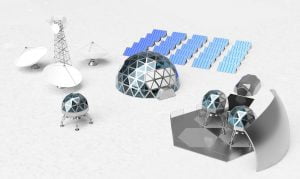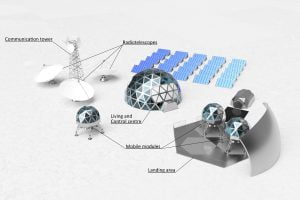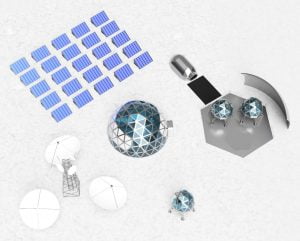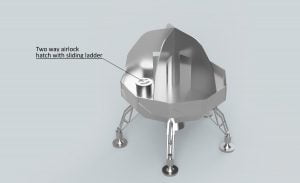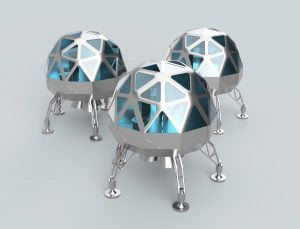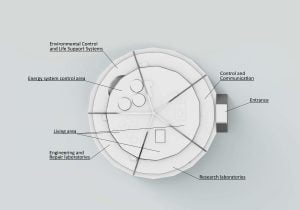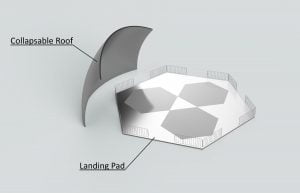Moon Camp Pioneers Gallery 2020-2021
In Moon Camp Pioneers each team’s mission is to 3D design a complete Moon Camp using Fusion 360. They also have to explain how they will use local resources, protect astronauts from the dangerous of space and describe the living and working facilities.
Team: Student Space Agency
High school of Mathematics “Dr Petar Beron” Varna Bulgaria 18
External viewer for 3d project
|
Project description
We, Anton and Sasha, created a project Mobile Moon Base, called “Moon Walkers”. This is extremely challengeable and great adventure for us. We are confident, that we are creating our future workplace. This hard-working and interesting project took us many months. We have been learning astronomy for 3 years at the Naval Planetarium of the Naval Academy. By designing the mobile moon base, we tried to make it multifunctional and free-standing. Our moon base is different and unusual. It includes one Mobile Moon Base (three moving modules) and three static stations. The first mobile module from the Mobile Moon Base will conduct scientific research – video and radio research of the Sun and other astronomical objects. The second detachable module will be intendent to survey the moon regolith, also researching and mapping the mineral constitution and structure of the lunar surface. The third module will be designed to accomplish early scientific research in specially selected lunar areas. We will be able to fly and explore huge territories on the moon. All three modules are comfortable, they allow people to work there and relax at the same time in a solar radiation protection environment. We also designed three Static Moon Bases (they are similar to the earth electric stations). In there, the mobile modules will charge their batteries and the modules will stock with supplies – food, air, and any necessary resources. |
|||
|
Where do you want to build your Moon Camp?
The Mobiles Modules will do research in specially selected areas, they are going to move through a special course. All three Static Moon Stations will be located on the Equator at a distance of about 1100 km from one another. How do you plan to build your Moon Camp? Describe the techniques and materials you would use.
The Mobile Moon Base consists of three mobile modules and three static stations. The three moving modules are going to be built and brought to the moon via a Space Station located in orbit around the Moon. For producing electricity, we will bring solar panels from the stations, too. Each section of the stationary stations is going to be assembled and built on the three chosen places. We will build the biosphere, command and residential sections and the communication tower with the assistance of 3-D printers. The basic constructions will be brought, and after that we can print the foundation walls and the parts that separate each room from one another. Main blocks which prevent the sun radiation will be brought and built into the command, residential and biosphere sections, where we are going to grow plants. The environment on the Moon is very dangerous for the astronauts. Explain how your Moon Camp will protect them.
In 2020, the Chinese lunar rover made the first detailed measurements of the intense radiation that bombards the lunar surface and found it safe for long-term human presence. Astronauts in a mobile lunar base can stay on the moon’s surface for a maximum of two months without taking special protective measures. But according to scientist Wiemer-Schweingruber, if people come to stay on the lunar surface for more than two or three months, there must be built buildings protected from radiation with a 80-centimeter shell of lunar soil. Therefore, we provide emergency rooms in the mobile modules that have walls of special protection from polyethylene with water in case of a solar storm. The three stationary stations will have lunar regolith hangars, specially made with 3D printers, with thickness of one meter, so that in case of a solar storm or a long stay in the mobile modules, people can hide. Explain how your Moon Camp will provide the astronauts with:
|
|||
|
Water
|
Food
|
Electricity
|
Air
|
|
The latest lunar research from NASA shows us that there is water on the Moon in both the shady areas at the poles and on the flatter surfaces, even though it is in smaller quantities. Casey Honniball, postdoctoral fellow at Nasa’s Goddard Space Flight Center in Maryland had said that the amount of water is roughly equivalent to a 12-ounce bottle of water in a cubic metre of lunar soil. At the beginning certain amount of water will be brought from Earth. A very powerful system for water recycling will be mounted. Its main purpose is to ensure that the water can be used for drinking and food. After a while, the lunar ice will be used to recover all the supplies. |
The crews from the three modules will stock themselves with food from biospheres in each of the static stations. Each of the biospheres will have specific equipment: section – farm where selected plants are going to grow in places with food solution gel. On the entire surface of the biosphere will be located layers of secondary inner shell of polyethylene filled with water. It will have a dual role. On the one hand it would be like radiation shielding which is offered from the Al Globus and Joe Strout in the article Orbital Space Settlement Radiation Shielding, and on the other hand, it would be an environment for growing diatoms to eat and for protection from the sun and space radiation. We also consider using algae for food. The idea comes from two Danish people – Sebastian Aristotelis and Karl-Johan Sørensen who decided to make green wall, so they said: “We strongly believe that Algae will play an important role in future space travel, as a biological Life Support System. It is resilient, highly photosynthetic, nutritious, and can absorb cosmic radiation.” Meat for eating will be obtained by stem cells in special containers. |
Electricity will be obtained in two ways. The first way is using small nuclear reactors, which have been already designed in moon bases in NASA, in the Russian Federal Space Agency ”Roscosmos”. The second way is through a large number of solar panels. We will convert solar energy into electricity in the two weeks when it is continuously a full lunar day. We will charge special large batteries that will be used by mobile modules and stationary stations. In addition, we will use lunar ice to separate ice water into hydrogen and oxygen, and hydrogen will be used precisely as a fuel to power mobile base engines. |
Air will be found in the special sector of the biosphere, just as in the International Space Station. Electrolysis will be used to decompose the water into oxygen and hydrogen and expel the dioxide out of the rooms. Another method will be used to obtain oxygen from the moon dust. This is also what Beth Lomax, a researcher at the University of Glasgow, involved in the project, said in a press release from ESA. “The ability to obtain oxygen from resources found on the moon would obviously be extremely useful for future lunar settlers, both for respiration and for local rocket fuel production” |
|
Explain what would be the main purpose of your Moon Camp (for example: commercial, scientific, and/or tourist purposes).
The main purpose of our Moon Mobile base is to be multifunctional. Our goals are scientific and educational. The Moon Mobile modules allow for maximal exploration of the lunar surface and its mineralogical composition. In addition to that, the cave explorer can tell what’s happening under the surface, while radiotelescopes scan the sun and other sky objects in the radio specter. Our Moon Mobile base also lets young scientists and university students work on other projects outside of the astronauts’ main program. We aim to develop an oppurtunistic environment for sustaining life on the Moon in the long-term. |
|||
|
Describe a day on the Moon for your Moon Camp astronaut crew.
Welcome to the “Moonwalkers” Mobile Moon Base. It consists of three mobile modules. They are assembled at a lunar station and transferred to the moon. A long lunar day begins and it lasts 14 Earth days. A team of 18 people will work on an interesting scientific program for one lunar month. In each module there are 6 moon specialists who live and work there. Their life and work are subject to the earthly day and night – up to 7 hours of sleep and the rest of the time is time to work. There will also be small breaks. Working is in shifts. When 3 people are working, another 3 are resting. Each specialist has at least two qualifications. The teams of each module have different programs. The first team includes astrophysicists. The lack of a lunar atmosphere allows for very important studies of the Sun, close and dangerous to Earth comets and asteroids, stars and Deep Sky Objects. The second team will study mainly gravitational anomalies on the lunar surface. Today we are in a unique area in the Ocean of Storms, characterized by low hills, special chemical composition and ancient volcanic plains. This region has a high concentration of radioactive elements that produce heat in the region’s crust and mantle. The third team includes young scientists and students working on research projects at their Universities. After completing the work on the tasks of the scientific program, we can fly to the nearby Stationary Moon Station, one of the three on the lunar equator. There, we will charge our electric batteries, stock up on food, water, air and everything we need. We will carry out urgent repairs. To prepare for a new jump on the lunar surface, new discoveries not found yet, and interesting lunar research. |
|||


